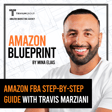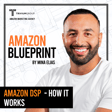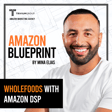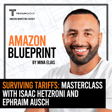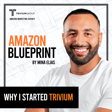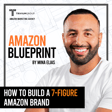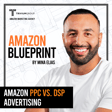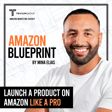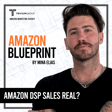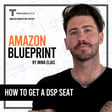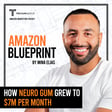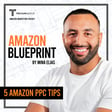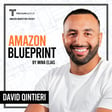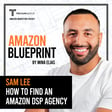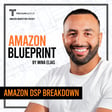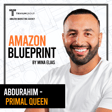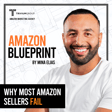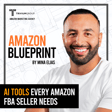Become a Creator today!Start creating today - Share your story with the world!
Start for free
00:00:00
00:00:01

Optimize your Amazon SEO to Increase Sales & Rank on Amazon
In this episode, I break down how I optimize my Amazon SEO.
When you have good Amazon SEO, it increases your organic rank on Amazon and also increases your sales.
If you'd like help scaling your Amazon brand, Click here: https://hubs.la/Q02D27tg0
Transcript
Introduction: Profitability over Revenue
00:00:00
Speaker
Welcome back to the Amazon blueprint podcast.
00:00:05
Speaker
everyone is always flexing the revenue numbers on amazon i made a million last year i made three million five million ten million but you know what matters more than revenue it's actually bottom line profit and it's not profit percent it's not a thirty percent profit margin or a fifty percent profit margin It is literally cash in profit that ends up being deposited into your bank account that you can take home, you know, and you can invest back into your business, things like that, right? Bottom
The Role of Analytics in Profitability
00:00:31
Speaker
line profit. And in this episode, I'm going to break down everything that you can do to improve your profitability on Amazon. So let's get started.
00:00:38
Speaker
First things first, we need clear analytics. There is no way that you can improve your profitability on Amazon if you don't see your profit margin perfectly every single day. And if you can't see all the factors that affect it, right? So I have built custom analytics on Myro Profit. They're called Trivium Analytics. And in those, you can see your sale price minus your Amazon fees, minus your cost of goods sold, minus your PPC, minus your refunds and reimbursements, minus your discounts. You get the gist, right? And we can see the bottom line profit per product every single day. And you need that level of analytics. Now, on top of that, we've built dashboards where you can see week over week, spend changes, sales changes, click-through rate changes, conversion rate changes, and most importantly, what your bottom line profit is per product this week and last week. And you can compare what actions did I take and then did that result in my profit improving or worsening.
00:01:29
Speaker
And if you don't have that level of analytics, it's very hard for you guys to improve your profitability on Amazon because you're going in blind. You don't know. And I know a lot of people use a lot of different tools. Some people use Helium 10 and all that kind of stuff. I think that is too rudimentary. It is not going to work out. I think you need something advanced. I think you need something where you can put a correlation between your conversion rate and your profit. your ad spend and your profit, your daily changes in your ad spend and your daily changes in your profit, not something that just says, here's a snapshot of
PPC Strategies: Revenue vs. Profit
00:01:58
Speaker
yesterday. right Okay, great. I know what my profit was yesterday and last week and last month. How does that help me make decisions? right I need a way where I can correlate actions that I'm taking on my account with different metrics
00:02:10
Speaker
ad metrics, you know, PPC metrics, conversion rate metrics, click-through rate metrics, all these different things and correlate that to profit, okay? Next, let's get into PPC. How does PPC affect profitability? Obviously, the way to optimize for profitability is to identify bleeders and eliminate them, right? So identify keywords that are spending money and not making sales and identifying keywords that have a very high ACOS and low sales and eliminate those keywords or spend less money on those keywords. but One thing I want to touch on, more importantly, before I get into optimizing for profit, is if you want to have profitable PPC campaigns, you need to work in one of two phases. You're either scaling for revenue or optimizing for profit. Doing both at the same time will hurt you.
00:02:51
Speaker
so When I say scaling, I mean you're going in one direction only. You're launching campaigns, increasing bids, increasing budgets, increasing bid by placement, trying different types of you know ads like sponsor brand or a sponsor display. The reason that you want to do scaling only in one phase because if you increase bids on certain keywords and decrease bids on other keywords, you don't know what affected your profit margin. You don't know what affected your bottom line and profit. Because on one end, you're increasing bids for other keywords, you're showing up higher. On the other end, you're lowering bids for keywords and you're showing up lower. So why did the profit improve or why did the profit get worse? Was it because of the increase in bids or was it because of the lowering in bids?
Understanding Profit per Unit and Break-even Points
00:03:31
Speaker
So that's why I want you guys to focus on one thing at a time. If you're scaling, you need to increase bids, increase budgets, increase bid by placement and focus only on growing revenue and understand that your profit is going to go down.
00:03:42
Speaker
But what's going to happen is you're going to get more sales velocity, better unit sales, and that's going to improve your organic rank. You're also going to discover a lot more profitable keywords, right? Then you go into the profitability phase where you are lowering bids, adding negatives, removing bid by placement. For bid by placement, for example, where the performance wasn't that good, you're gonna lower that bid by placement. So you're taking actions where you're only lowering things and eliminating things that did not work, so you can leave all of the keywords that did work that were super profitable, and then all of the stuff that didn't work, you're eliminating it, so you're just left with stuff that's performing well. And as a result, your bottom line profit should go up.
00:04:20
Speaker
All right, guys, and a pro tip here, you need to understand your profit per unit, right, which is your sale price minus your Amazon fees minus your cost of goods sold because that is going to help you understand what your break even conversion rate is. And break even conversion rate is basically what conversion rate do you need to be so that you can break even. So when you understand your profit per unit, you understand how much total profit you have before ads. right And then once you know that, you can understand how much can you spend per unit on PPC so that you can break even. So let's say you have $10 in profit per unit before PPC, before ads, you can spend $10 on PPC to acquire one
Blended Cost per Acquisition and Cash Flow
00:04:58
Speaker
customer. And after that point, you become not profitable.
00:05:01
Speaker
So you need to understand those numbers to understand what is my profitability. You also need to understand your blended cost per acquisition because your blended cost of acquisition is your total cost for acquiring a customer divided by the total number of customers. So how much did you spend to make a sale divided by the number of sales that you made? That will give you your blended cost per acquisition. So your total cost of acquiring a customer is your spend divided by the number of units. So, your blended CPA is basically your total cost divided by the number of units, which is going to give you your cost per unit. That is your blended CPA. Now, to break even, that blended CPA needs to equal your profit per unit. If that blended CPA is larger than profit per unit, you are going to be in the negative.
Enhancing Click-through and Conversion Rates
00:05:44
Speaker
If it's lower, the lower it is, the more profit you have after everything and the more profitable you are. All right, let's get more into the tactical stuff. One of the biggest things that affect your profitability is going to be your click-through rate.
00:05:56
Speaker
Your click-through rate is your clicks divided by your impressions. Why? Because for the same advertising spend, it is going to result in more people coming into your listing. And for the same organic ranking, it is going to result in more people coming to your listing. So even though you're spending more money on ads, you're also getting way more people coming into your listing from organic, which will help cover that. And as a result, with conversion rate being the same, you're going to convert better. But not only that, I've noticed that with a better click through rate, I'm getting lower cost per click. It's a phenomenon that I'm seeing. I don't understand why it's happening. My best guess is that Amazon wants to reward people that are providing a good customer experience for their customers. So when shoppers are clicking a lot on a certain product, Amazon thinks that this is a good product for them and it shows them up more in the search. And as a result, it wants to drop their cost per click to get them to spend more money on ads.
00:06:47
Speaker
Now, what is a good click-through rate? So, what I consider a phenomenal click-through rate is anything above 0.8%. 0.4 to 0.6 is good. 0.6 to 0.8 is very good. 0.2 to 0.4 is okay. You know, you're kind of like a C student, maybe a C minus student. Anything under 0.2% is just bad. You have a a major issue and this is gonna hold you back from scaling. And so, this is also what is going to hold you back from actually growing your brand. If your click-through rate is too low, Your ads won't work well enough. Your organic sales won't be high enough. And as a result, you will not be able to scale. You won't be able to get that profitable. So by optimizing click-through rate, you're able to improve profitability. What are the factors that affect click-through rate? Your main image, your price, your reviews and your star rating, having any discounts and coupons if you're FBA versus FBM and badges, right? And I have an entire podcast episode dedicated to how to optimize click-through rate and conversion rate. So I highly recommend you guys check that out. Also have a YouTube video about it.
00:07:44
Speaker
on my channel, Mina Elias on YouTube. So go check that out. But essentially, you need to optimize click through rate because that is going to improve your performance. It's going to result in more organic sales and it's going to improve your profit. And you guys guessed it. The second factor that is gonna affect your profitability is conversion rate. So things that affect conversion rate are the rest of your images, videos on the listing, bullet points, virtual bundles, brand story, premium A plus content, UGC videos on the listing, Amazon posts, and then videos and images in the reviews All of those things improve conversion rate. Now, obviously with everything being the same, a better conversion rate means more profit. And one of the craziest things is that most people I know, most brands that I talk to are not focused on improving click rate and conversion rate enough. They do not have a consistent strategy on how to get more reviews. They do not have a consistent strategy on how to optimize their price. So those are all things that you need to have a big focus on and I personally focus on
00:08:37
Speaker
one thing a week that I want to improve in my listing, whether that's improving a main image, improving the listing image, adding a new video, updating my premium APOS content. I want to make sure that every single week I'm working on something that is going to improve my click through rate and conversion rate and allow more people to come into the listing and more of them to convert. Because again, that is going to result in more of my organic traffic converting into sales.
Supply Chain Optimization for Cost Reduction
00:08:58
Speaker
So that's all free additional profit. But also all of my paid traffic will perform way better and it will convert better and my echos and my tacos is going to improve. Alright, next, let's talk about some other things. Supply chain. How does supply chain affect profitability? Direct shipping to Amazon fulfillment centers will help you reduce your costs. If you typically use a freight forwarder and you ship products from your manufacturer to a 3PL and then from a 3PL to Amazon, shipping directly to Amazon fulfillment centers will help Now, another thing is to be smart about how you package the product and how you send it to different fulfillment centers. right Amazon right now is dropping the price significantly if you send it to multiple fulfillment centers. So you want to be smart about your shipping. You should definitely consult with an experienced freight forwarder and understand how you can manipulate your shipments so that you can reduce the cost of shipping to Amazon. That's going to impact your bottom line. I personally was sending everything all to one fulfillment center
00:09:51
Speaker
But then, when I started breaking it up and sending it to different fulfillment centers, based on what Amazon was asking me to do, I was able to drop the cost of my shipping by about 60%, and not I'm not even exaggerating, 60%. Alright, next, maintaining 2-3 months of extra stock at a 3PL. Now, that sounds counterintuitive. You're like, Mina, you are talking to us in this episode about how to improve profitability. This is going to cost me way more money. How does that make sense? Well, first of all, stock is not actually an expense. Stock is an investment. You're taking your cash, you're converting it into a different form of value, and then when you sell that inventory, you're actually making money.
00:10:28
Speaker
on that So by you investing in two to three months of extra stock, you're not actually spending money. It technically will not affect your profit and loss statement. But by doing that and by having three months of buffer stock, you will avoid stock outs. You will also avoid any issues when sending products to Amazon because sometimes Amazon takes a lot of time to check in and sometimes they could lose a shipment. And if that happens, you'll have enough stock where you can send an emergency shipment to Amazon to cover that stock because I'm telling you, you will lose so much money and you will lose so much profit by running out of stock. By avoiding any stock outs, that is essentially improving your profits and improving your profit margins significantly, right? Because you can be ranked incredibly well, run out of stock for one week, and all of a sudden, all of your ad campaigns work way worse. Everything that you've worked so hard for is now
00:11:16
Speaker
all gone and you have to build everything back up and trust me, I've been in that position so many times and I've seen so many clients suffer and struggle because of running out
Negotiating Supplier Terms for Better Economics
00:11:24
Speaker
of stock. So make sure that you never run out of stock. Another point when talking about supply chain is negotiating favorable terms with suppliers. So here's a cool tactic that I did. I went and I looked at how many units I'm selling of each one of my products. So let's say my unflavored product, I'm selling about 18,000 units a year. So I went and I got a quote from one manufacturer for 9,000 units. So he came back with a quote, right? And that quote was, you know, an X number of dollars per unit. And I said, okay, what if I gave you 18,000 units for an order? How much would you charge me then? And he's like, oh, okay, let me work that numbers back. And then he went down and then I forced him to come down a little bit more. And so by the time that we got to that number, it was significantly less than how much I was paying right now. But then here's the catch. I said, listen,
00:12:06
Speaker
I will put a PO for that entire amount. However, I want terms and I want the terms to be that I will pay net 30 after you ship out each batch of products. And we went on a schedule and the schedule was I'm selling 1500 units a month. So I want 1500 units a month to be shipped out every single month for the next 12 months. The PO secured for the entire 18,000 units, but I will pay only for the 1000 units that get shipped out 30 days after they get shipped out. So essentially what I created was almost a negative or a zero cash flow cycle. And what a cash flow cycle means is basically the amount of time that it takes from you putting money down for inventory until you getting that money back from customers. All right. So let's say today is January 1st. I paid $10,000 for a thousand units of inventory. It took four weeks to produce, four weeks to get on a boat and get shipped to Amazon, two weeks to check in. So that's four plus four is eight plus two is ten.
00:12:58
Speaker
and then another four weeks to sell. So that's 14 weeks. So my cashflow cycle here essentially is 14 weeks. It takes 14 weeks from the time that I pay that PO o up until the time Amazon pays me all of my money from that inventory. So what I did is I said, okay, if this guy ships my product and it goes to Amazon, it should take a day to get to the Amazon warehouse about a week into check-in and then it'll sell in three to four weeks. So essentially, Amazon was paying me the money from those customers right around the time that I had to pay my manufacturer. And by doing that, I'm able to scale very, very, very profitably.
Product Variations and Conversion Rates
00:13:30
Speaker
And not only that, I'm able to secure way better unit economics for my products, which obviously improves profitability. All right, let's talk about something different, variations. How do variations affect profitability? Here's what I found. Launching additional variations helps profitability because for the exact same listing, you can get more variations up and you can get more of the same sessions to convert. So what do I mean by that? Let's say I have a thousand sessions a month.
00:13:54
Speaker
coming into one of my product listings. Out of those 1,300 convert, that is a 30% conversion rate, and they convert on the hard work unflavored product. Let's say I added a mango pineapple variation. Now, out of those 1,000 same sessions, I have 400 people converting, because 100 of them like the mango. They didn't like the unflavored, but they like the mango. Now I have a 40% conversion. Now, let's say I added Blue Razz. Now, out of the thousand same sessions, I have 500 people converting. That is a 50% conversion rate. It went up from 30% to 50% because an additional 100 people wanted to go after the blue rats. Now, obviously, some of the initial 300 from the unflavored might go and get the mango pineapple, might go and get the blue rats. So maybe it's not going from 300 to 500. Maybe it's going 300 to 450 or whatever.
00:14:42
Speaker
but Essentially, by launching more variations, I am able to take advantage of that exact same traffic that I'm getting into my listing.
Adjusting Pricing for Maximum Profit
00:14:50
Speaker
I'm able to take more advantage and convert more people into customers. And so I always advise brands before launching new products, always try and launch more variations and maximize the amount of revenue that you're getting from your existing traffic before trying to go after new traffic. All right. And one final thing I want to touch on, right, because this is super important. your price. Your price that you set on Amazon is very, very crucial to how much money you make. I was able to increase my price from $28 to $38 with no significant impact in unit sales velocity and click rate or conversion rate. And as a result, I was making 35% more profit per month after doing that. And I literally have the P and&L and I was looking every single month, how much did I charge? How much profit did I make? And so
00:15:34
Speaker
What I want you guys to do is I want you to test increasing your price, test increasing by a dollar and then $2 and then $3 and then $4. And what I want you to focus on is not how much revenue you're making or how many units you're selling, but how much bottom line profit you're making. And if you notice that by increasing your price, your click through rate is going down, your conversion rate is going down and you're selling less units, but because your profit margin per product is more and profit per unit per product is way more, you're now making more in profit. I much rather prefer make the same amount of dollar profit or more right with way less units, right because it means way less reordering and all this inventory management stuff, way less. right So I want you to really try and invest in optimizing your price, try lowering your price and seeing if that improves your unit sales by a lot. right And so let's say I i was selling for 28 and I go down to 26,
00:16:26
Speaker
And instead of selling 1,000 units, I'm now selling 1,200 units. 200 units more is obviously significant, right? Even if I lost $2 in profit per unit, I'm making way more sales, so it's helping me a lot. But also try the other direction, right? Going from 28 to 29 to 30, 31, 32, 33, 34, and seeing, okay, is my click through in conversion rate decreasing? If it's not, or if it is a little bit, but my profit is improving, That's what I care about. I care about my profit dollar amount. I do not care about what my revenue is.
Using AI for Dynamic Pricing
00:16:57
Speaker
I do not care about how many units I sold because that does not mean anything. I can't take that to the bank. I can't withdraw revenue from the bank. I can't withdraw unit sales from the bank. And one golden nugget for you guys. I use a tool called prophecy. p r o f a s e e
00:17:11
Speaker
It is an AI based price changer. It's the only one available right now for people who are not wholesalers. There's price changing software for wholesalers, like people who are selling under the same listing, right? Like, you know, you're selling like Nike's products or whatever. But for you know someone like me who has a brand, I don't have any other competitors on my own listing. Right. How do I change my price to be able to take advantage and get the most amount of profit? So prophecy is based on AI and it's been changing my price like dynamically all the time between you know 33 all the way up to 38 and Seeing at different times of the day and you know different changes or whatever of the market What is the best price and how can I make the most amount of money and it's been working phenomenally? Well for me it's 600 bucks a month So it's super cheap and it's added way more than that in terms of profit like I think I would I from $14,000 a month in profit to $28,000 a month in profit. So not only because of prophecy, right? It's because of everything that I mentioned in this episode, but it's definitely worth checking out. All right, guys, that's it for this episode. I hope you enjoyed it. I highly recommend you guys go and listen to the other episodes I have on here and go check out my YouTube channel, Mina Elias. I'm dropping a ton of fire content on there. All right, guys, see you in the next episode.
